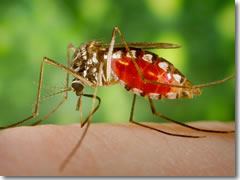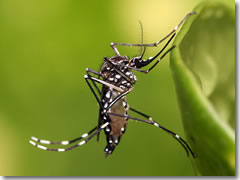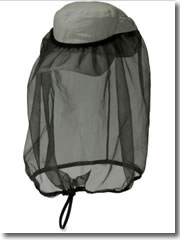Avoiding bug bites
A traveler's guide to warding off mosquitoes, ticks, and other biting beasties (and the diseases they can carry)

A mosquito enjoying a meal. Most countries have yet to discover that marvelous modern invention: The window screen. This wouldn't be so bad if hotel maids the world over weren't prone to leaving your windows every day to air out the room—and let in the bugs.
Avoiding bug bites and wearing insect repellant aren't just a comfort issue, it's a health concern as mosquitoes and ticks can carry disease—most famously malaria, but also dengue fever, yellow fever, Japanese encephalitis, and other nasty things you don't want to catch.
Mosquitoes: Avoiding malaria and dengue fever
Stay inside in the evenings
Most mosquito species tend to swarm from late afternoon through late evening, so staying inside at dusk is the best way to avoid getting bit (as much).
If you are out, try to stick to breezy areas. At tropical seasides, I find I am often fine if I stay by the beach kissed by the sea breezes, but get eaten alive if I stray even one block inland where buildings block the wind. (Also, tables set in the sand make for a much more romantic and evocative dinner setting.)

The Aedes aegypti mosquito that infamously carries both dengue fever and yellow fever. (Photo by Muhammad Mahdi Karim) However, since the malaria-bearing mosquitoes are out at dusk but ones infected with dengue fever fly during the day, it pays to ward off the little bloodsuckers at all hours. And not just abroad—Dengue fever has recently cropped up in Florida.
(You know those zebra-striped mosquitoes that started showing up in North America about a decade ago? Yep, that's Aedes aegypti: the dengue carrier.)
Use bug spray
 Rule #1: Don't stint on the bug repellant. Yes it's messy and smelly and all, but it's far better than getting eaten alive.
Rule #1: Don't stint on the bug repellant. Yes it's messy and smelly and all, but it's far better than getting eaten alive.
Make sure you focus on the areas of your body the bugs most like to nibble: ankles especially, but also the nape of your neck and around your ears.
The big guns: mosquito nets
In tropical destinations and malaria-prone areas, make sure your bed has a mosquito net—and make sure you use it!

The OR Bug Net Cap is a personal mosquito net just for your head. I have a little mosquito net for just my head
—kind of like a beekeeper's netting, a bag with a cinch for the neck hole and a collapsible metal halo to keep it away from your face.
Yes, it looks inordinately silly, but on those occasions when the bugs are truly tormentous, it can be a godsned (and has saved me from a hundred itchy bumps everywhere from a beach on the Chesapeake Bay to a canyon in the Australian Outback).
Make your clothes bug-repellant

ExOfficio's Bugsaway Halo Shirt is treated with Permthrin to repel insects (and as a bonus comes with a sublock rating of UPF 30 and two hidden zippered pockets). In addition to spraying your skin, you can treat your clothes with Permethrin, which will turn them into wearable bug repellent (good for at least six weeks and a half-dozen washings).
Some specialty travel clothes come pre-treated with Permethrin (and, as it bonds to the fibers, the effect lasts much longer).
When you get bit anyway
Also handy: After Bite for the itch when, despite your best efforts, you do get bit. (Failing that, Tiger Balm works wonders.)
Section Index |
Related Partners
|
This article was by Reid Bramblett and last updated in August 2011.
All information was accurate at the time.
Copyright © 1998–2013 by Reid Bramblett. Author: Reid Bramblett.



 UltraThon™ Repellent
UltraThon™ Repellent Ben's DEET Wipes
Ben's DEET Wipes Natrapel Insect Repellent Wipes
Natrapel Insect Repellent Wipes Mombasa Nimbus Insect Shield Mosquito Net
Mombasa Nimbus Insect Shield Mosquito Net Sea to Summit Insect Shield Mosquito Head Net
Sea to Summit Insect Shield Mosquito Head Net Outdoor Research Bug Net Cap
Outdoor Research Bug Net Cap Permethrin
Permethrin AfterBite
AfterBite